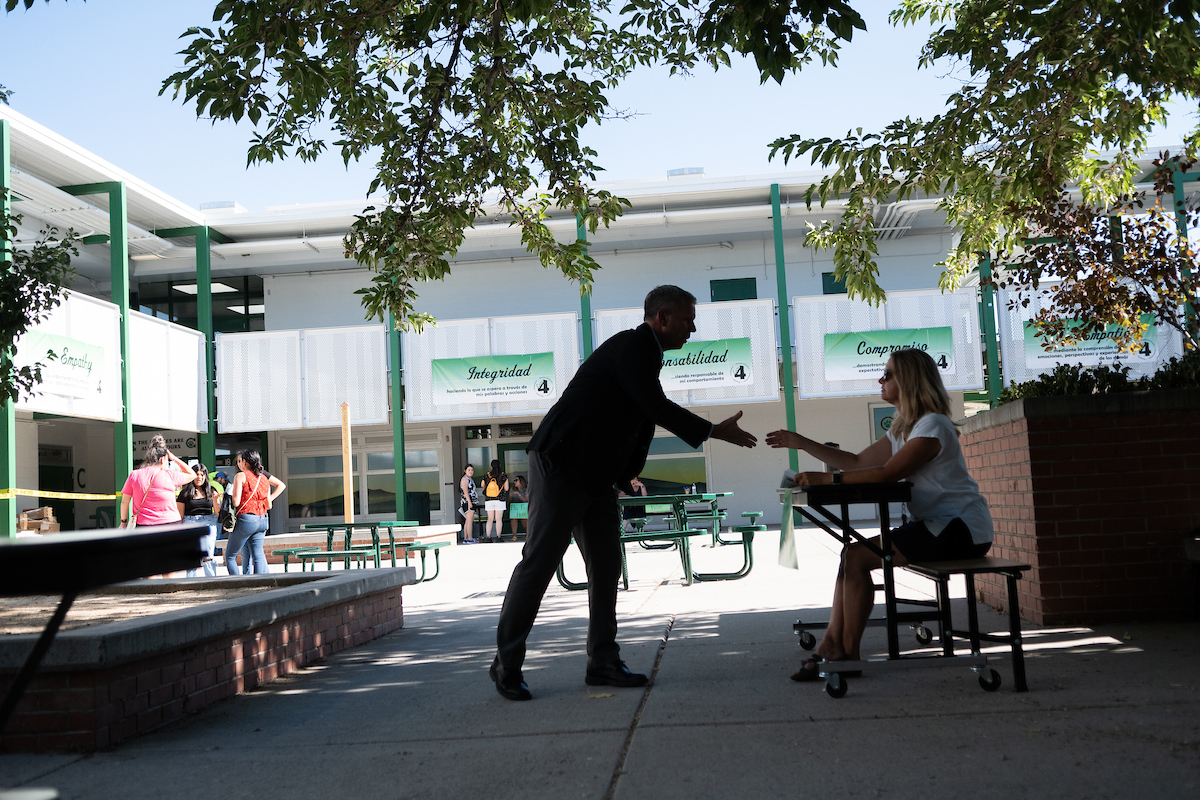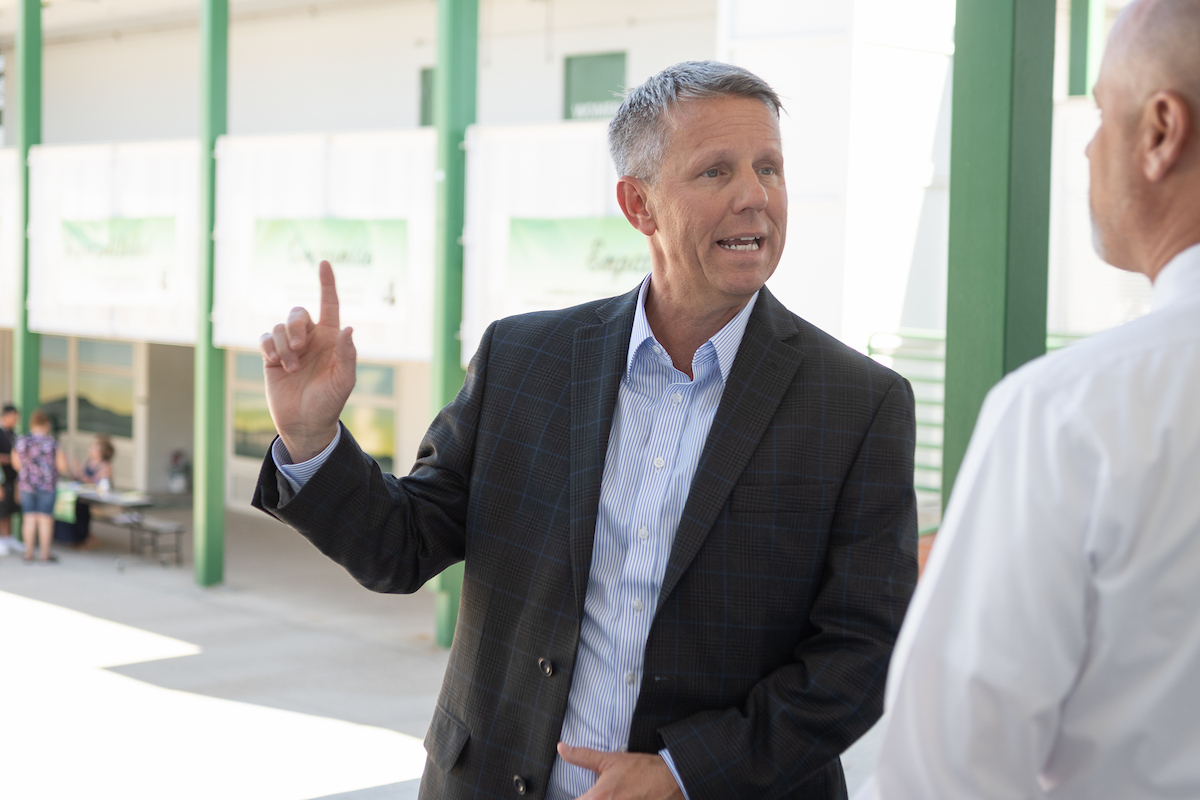Joe Ernst knew from a young age that he wanted to be a teacher.
Ernst, who officially stepped into his new role as the superintendent of Nevada’s second largest school district on July 8, says he found his calling back in elementary school while helping his best friend, who was “very smart” but struggled with reading and was held back.
“Each day, I went over to his house after school … and I tried to build on the strengths that he had to help him become a better reader,” he said during his interview with the school board in April.
Ernst has had many moments like this throughout his 28 years with the district.
One of the proudest moments of his career was seeing one of his students — who had faced many life obstacles and required constant supervision and support from his mother and the entire school — finally graduate.
“I have seen firsthand the power of education to dramatically impact the lives of our students, and I will tell you that my leadership is fueled by an unwavering hope and belief in what students can do and what they can accomplish,” he said.
Ernst, 53, is inheriting a district that continues to grapple with chronic student absenteeism, declining enrollment, subpar proficiency rates, teacher shortage issues and other hot button topics such as bans on cellphones and books.
“I think we’ve got a lot of positive momentum that we can build on, and just capitalizing on that momentum and making sure that we’re helping meet the needs of every one of our students,” Ernst said in a statement.
Setting roots in Washoe
Ernst started teaching in Michigan, where he was born and raised, but came to the Washoe County School District in 1996. He’s been there ever since.
Ernst said he has always been drawn to the West for its mountainous landscape and plentiful outdoor opportunities such as skiing and mountain biking.
Starting as a teacher at Donner Springs Elementary School, he worked his way up the ranks over the next three decades. Most recently, he worked as the district’s chief accountability officer, where he oversaw the district’s data, student records and grants.
Ernst is a father of three, including two current students.
His long tenure with the district is one of the reasons why Board President Beth Smith voted to appoint him as its next leader.
Ernst is the district’s fifth superintendent in the past decade. The district’s leadership turnover is in line with national trends since the pandemic, as leaders faced intense scrutiny on decisions related to COVID safety measures, school closures and culture wars.
“The average superintendent is only in their role for three years, and that is absolutely way too low,” Smith said in a recent phone interview. “You need at least three to four years of stability in leadership in a district, particularly one as large as ours, before you can actually see results.”
With longevity top of mind, the Washoe County School Board tied raises in Ersnt’s contract to the number of years he stays in the role and his performance, which Smith said was a big change from previous superintendent contracts.
Washoe Education Association President Calen Evans said the union appreciated the board picking an internal candidate rather than an external candidate without strong ties to the community.
“We need someone who’s committed to this community and who’s truly committed to collaborating with the union,” Evans said.

Chronic absenteeism
One major issue immediately facing Ernst is the district’s chronic absenteeism rate — which jumped to as high as 37 percent during the 2020-21 school year, and stayed above 30 percent during the 2022-23 year, slightly lower that the state’s rate of 35 percent, according to data from the Nevada Department of Education.
The state data includes all chronically absent students — defined as students who are absent for 10 percent or more school days for any reason whether they are excused or unexcused.
The district’s internal data (which excludes absences exempt under Nevada law for medical or religious reasons) paints a slightly more flattering picture — a 26 percent rate in the last school year. That rate is still higher than it was during the school year prior to COVID (19 percent) but 13 percentage points less than it was three years ago during the height of the pandemic.
Chronic absenteeism can cause students to fall behind academically, and contribute to low literacy and graduation rates. Nationally, the rate of chronically absent students has spiked since the pandemic — more than doubling from 13 percent in the 2019-20 school year to 28 percent in the 2021-22 school year, according to The New York Times.
One way the district is looking to reengage chronically absent students is by offering more extracurricular activities, including sports opportunities for sixth graders, an effort announced by his predecessor, former Superintendent Susan Enfield, and will begin this year.
Ernst said it’s not just about bringing chronically absent students back to school, but about making sure that schools have the proper systems in place to support them.
“Our students, when they come to school, they need to know that people see them, that people care about them, and that they have a trusted adult in the building whenever they might need that,” he said.
Enrollment
District data shows student enrollment has declined from about 64,000 students during the 2019-2020 school year (when COVID hit) to about 61,000 students last school year.
Ernst said the enrollment downturn is consistent with national trends. Data from the National Center for Education Statistics shows public schools lost 1.2 million students between the 2017-18 and 2022-23 school years. Experts attribute this to a rise in homeschooling and a shift to private schools.
Ernst cited Washoe County’s cost of living and the nation’s declining birth rate as two contributing factors to the district’s enrollment decline. The pandemic also had an impact.
“You had job losses, you had illnesses,” he said. “People moved away from the area during that time for various reasons, and then didn’t come back.”
The district is trying to connect with families to better understand why they left the district, and working to address those reasons. Ernst emphasized the need to be competitive among the various educational options available such as private schools, charter schools and homeschooling. That includes offering school choice options within the district.
In 2023, the district made it easier for families to apply to send their student to a different school than the one they are zoned for.
“We want to allow people to find the fit that best supports their child and their family needs,” Ernst said.
During the 2022-23 school year, more than 6,600 students — or about 10 percent of the district’s students — applied and were allowed to attend a district school other than their zoned school, officials said.

Proficiency rates
During the 2022-23 school year, 43 percent of elementary school students, 40 percent of middle school students and 46 percent of high school students were proficient in English language arts. Forty percent of elementary schoolers, 28 percent of middle schoolers and 22 percent of high schoolers were proficient in math.
The district’s proficiency rates are similar to the state’s rates for that same school year. They are all lower than the district’s rate for the last full school year before the pandemic hit.
Ernst said chronic absenteeism adversely affects students’ ability to learn and can also slow down classroom instruction if a teacher needs to spend time helping students who have been absent catch up.
He stressed the need for more engaging instruction and emphasizing science-based approaches to literacy instruction including phonemic awareness, which is the ability to notice, think about and work with the individual sounds in spoken words.
Teacher pay and vacancies
Last year, the district reached a new collective bargaining agreement that gave teachers a 20 percent cost of living increase over the two years of the contract. That included a 4 percent increase that was funded through a $250 million matching fund approved by the Legislature in 2023.
That raised the starting salary to $47,000 for a new teacher with a bachelor’s degree, a $6,000 increase from three years ago.
Though it still lags behind the $55,000 starting salary in Clark County, and Eureka County ($63,000), the pay increase may have helped reduce the number of teacher vacancies. Heading into the new school year, the district has 56 vacancies as of Friday, about half of the typical number of vacancies the district has during this time period. The district said 31 of those positions will be covered with long-time substitute teachers.
Ernst also credits the district’s work to bring former teachers back to the district. The district said retired teachers can draw their pensions while they’re working. Those that teach special education students can also receive a bonus of $2,500 if they stay for the whole year.
Cellphone, book ban debates
Ernst said the district is planning to have a discussion with the school board later this month on efforts to decrease cellphone distractions in classrooms — an issue that has taken root in Southern Nevada and nationwide.
The Clark County School District announced earlier this year that starting in August, all students in grades 6-12 will be required to store their cellphones in signal-blocking pouches during class. The policy has been met with backlash from some students and parents, who say cellphone access is important in emergency situations and a petition opposing the policy has gathered more than 20,000 signatures in opposition.
Mater Academy Bonanza, a pre-K-8 charter school in East Las Vegas, is adopting a similar policy, and the Carson City School District is considering following suit.
Another hot topic that’s hit school districts nationwide, including Washoe County, are efforts from conservative groups to ban certain books from school libraries. Ernst noted the district already allows parents to request their students not be allowed to check out certain books by reaching out to their child’s school principal and librarian.
For now, Ernst’s thoughts are focused on Aug. 12, when the new school year begins.
“I always think the start of [the] school year is an exciting time. I can’t wait to see our students and our families,” he said.

